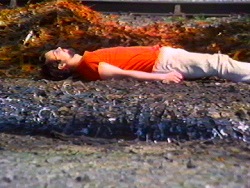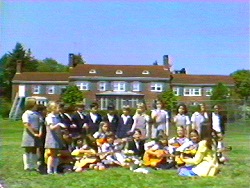Junkyard Levitation is a visual pun on the concept of "mind over matter," as a man attempts to levitate while lying prone in a junkyard. Writes Viola, "Scrap metal technology and video technology are united to temporarily break the known laws of science and prove that psychokinesis is valid...
Here Viola directly references the visionary Romanticism of William Blake, as shifting light is charted through the passage of a day. Images of children singing dissolve and reappear, hovering at the edge of perception, evoking what Viola terms "a visual relationship between memory, the setting of the sun, and death."
The Space Between the Teeth is based on the structure of acoustic phenomena and the psychological dynamics of a man screaming at the end of a long dark corridor.
An isolated figure is seen performing successively more aggressive actions - dropping a cymbal among a flock of pigeons, firing a rifle in a deserted city street. Finally his luminous image, spotlit against the dark night, merges in the distance with a roaring crowd in an outdoor stadium.
Description
In terming these tapes "songs," Viola references the relation of his work to musical structures and to the poetics of Romanticism. Junkyard Levitation is a visual pun on the concept of "mind over matter," as a man attempts to levitate while lying prone in a junkyard. Writes Viola, "Scrap metal technology and video technology are united to temporarily break the known laws of science and prove that psychokinesis is valid within a given frame of reference." Songs of Innocence, which directly references the visionary Romanticism of William Blake, is haunted with symbolic transformations, as shifting light is charted through the passage of a day. Images of children singing on a school lawn dissolve and reappear, hovering at the edge of perception, illusion and reality, evoking what Viola terms "a visual relationship between memory, the setting of the sun, and death."
The Space Between the Teeth is based on the structure of acoustic phenomena and the psychological dynamics of a man screaming at the end of a long dark corridor. With each successive scream, the camera point of view hurtles at high velocity along the length of the hallway in decreasing increments. The corridor and the cinematic structuring of the camera's advance act as metaphors for passage and transition between two worlds, bridged by the individual's cathartic screams. Ultimately, the image of the man at the end of the corridor is transformed into a Polaroid still that is literally washed away.
The title of Truth Through Mass Individuation references Carl Jung. An isolated figure is seen performing successively more aggressive actions — dropping a cymbal among a flock of pigeons, firing a rifle in a deserted city street. In the fourth and final stage, his luminous image, spotlit against the dark night, merges in the distance with a roaring crowd in an outdoor stadium.
Technical Assistance: Bobby Bielecki. Produced in association with the TV Lab at WNET/Thirteen, New York. Portions produced at Synapse Video Center, Syracuse University.
Exhibition & Distribution Conditions
SCREENING REQUIREMENTS for museum or gallery presentation:
The video should be presented as cinema. Projection in a dedicated, darkened gallery is strongly preferred. Accompanying floor plans and technical specifications regarding projection equipment is appreciated. Videos must be shown in original 4:3 aspect ratio, either using projector settings, as available, or pillarboxed with black masking.
Seating must be provided for the audience, and works must be shown according to a published schedule, not presented as an automatically repeating loop. Works cannot be incorporated into looping programs with other titles. Audio must be handled through a separate stereo sound system (amplifier and two speakers).
Please contact the EAI office (info@eai.org) for further information regarding monitor displays. Presentation on monitor may be permitted in certain instances, but the use of headphones or sound through built-in speakers is not permitted.




